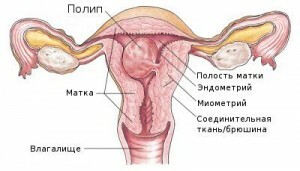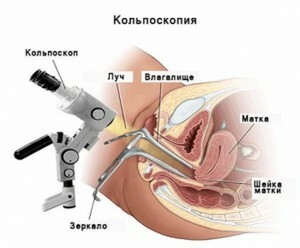Polyp is a benign neoplasm that can occur on different parts of the uterus. He rarely regenerates, but can seriously complicate the life of a woman, negatively impacting well-being, not giving the opportunity to become pregnant. This is one of the main reasons why it is necessary to get rid of the tumor. It is natural that the monthly after removal of the polyp takes on a different character, which means that many functions of the body are restored.
Why the polyp

interferes Polyps can reach a size of up to 3 cm. Their surface is porous and all riddled with blood vessels. About the exact causes of the appearance of neoplasms in women of different ages and even teenage girls is unknown. Specialists assign a significant role in this hormone.
Polyps in the uterus are located either on its inner surface or on the neck. Sometimes nothing shows about their presence. But in frequent cases, a woman notices that her menstruation has become different.
Monthly for a polyp get:
- Irregularity;
- Soreness, greater than before;
- Unevenness in the amount and consistency of precipitates.
Neoplasm often provokes the development of anemia, infertility. Therefore, it is important for women of all ages to know what polyps are, symptoms and treatment. At monthly with the changed characteristics there are bases to search for the reason of indispositions in it or this.

Features of the endometrial polyps

The ovarian hormone producing hormones do not always function correctly. If the estrogen predominates in the total amount of hormones produced by them, this provokes excessive growth of the endometrium. Part of his cells, instead of leaving with discharge during menstruation, remains inside the uterus. If this occurs for several months, at the points of the congestion of the endometrium, growths are formed. Gradually they are filled with vessels and connective tissue. This is a ready-made polyp. To see it, if it is located inside the organ, you can, using ultrasound, hysteroscopy or X-ray.
Endometrial polyp endometrial makes:
- Abundant. At what in allocation the most part makes a blood that worsens a general condition of the woman, threatens an anemia;
- Intermittent. Actually, it looks like this, but in fact bleeding occurs between menstruation. The polyp is an alien formation, from which the uterus is trying to free itself, which gives out a daub in a few days after the critical. Sometimes there are a lot of these excretions;
- Continuous. Due to the multiplication of the number of endometrial cells, menstruation does not fit into the usual period. Its length can be 7 days or more;
- Painful. The uterus shrinks more often, which increases spasms.
Polyp, delay in menstruation is also a frequent combination. Hormonal disorders and hemorrhages knock down the cycle so much that it is difficult to keep the calendar. The delay can range from 2 weeks to several months. The egg does not ripen, hence the infertility of the polyp.
Menstruation for cervical polyps
Polyp of the cervix affects its menstruation, which is due, inter alia, to its location. Neoplasm can be localized inside the cervical canal or on its outer part. In the first case, a sparse monthly polyp causes, as it interferes with the discharge of excreta. This increases the risk of inflammatory diseases and causes bleeding between menstruation, as part of the endometrial tissue lingers longer than the prescribed time in the uterine cavity. Often, such allocations occur before critical days. They are of brown color and are accompanied by drawing pains in the lower abdomen.

The polyp of the cervical canal and the monthly and other days of the cycle is able to significantly change, no matter where it is located. Neoplasm often exists against the background of other gynecological diseases, and therefore it is characterized by profuse menstruation, delay and bleeding. In addition to the problems listed above, one can be added. Often a traumatized large polyp( from 2 cm) becomes inflamed and causes purulent discharge from the vagina. They can be seen and in addition to menstruation, and in time for them, giving the discharge a brown color.
How to get rid of the polyp
Even if the tumor is small, it can cause significant health problems: from irregular cycles to persistent infertility. Treatment of polyps and menstruation normalizes, and stops uterine bleeding between them. And most importantly, it helps to restore fertile possibilities. If a polyp is found at an early stage, try to eliminate it with hormones:
- . Oral contraceptives, if its value is less than 10 mm, the patient is 35 years old, bleeding and a cycle failure occur. These funds are prescribed for 2-3 weeks;
- Antibiotics if the cause of the growth of the polyp is determined by a chronic infection. Before the appointment it is necessary to make an analysis for the flora;
- Preparations containing progesterone( Dufaston, Utrozhestan), if endocrine disorders are detected;
- Preparations of iron, vitamins with frequent bleeding;
- Dipherylin if a woman is over 35 years old.
Gestagens and gonadotropins take up to six months. At the end of this time, it becomes clear whether the therapy has helped or will have to use other methods.
Taking medication is interested in whether a polyp can come out with a monthly. This happens with small formations. For a polyp, a woman can also take pieces of endometrial tissue that are contained in menstrual flow. It is not worth stopping the therapy. If it seems that the polyp came out with a monthly, it is necessary after that to be examined and, if possible, to provide the material to the gynecologist, keeping it in saline.
Surgical treatment

In case of unsuccessful medication, surgical removal of the polyp is required. It is made using a hysteroscope, a simple scraping or laser. There are different opinions about whether it is possible to remove polyps during menstruation. On the one hand at this stage, the endometrium is already being updated, so that the manipulation will take place with the least consequences for the woman. Such intervention is more physiological, since it does not violate the time frame and stages of the cycle. On the other hand, menstrual discharge and thickness of the endometrium can prevent the equipment and the doctor from seeing the neoplasm and removing it qualitatively. And in this case it is not ruled out that it will again grow in the same place. The material that specialists receive in this operation is not very informative, since the cells of the upper layer of the endometrium are already dying out. That is, he will not give an idea of whether there are malignant ones among them. The polyp is removed during menstruation, if you have to do a curettage to stop bleeding. When it is located on the cervix, this option is also possible. The cervical canal at this stage is so open that the new growth on the leg is clearly visible, and it is easy to grasp the instrument.
When after a month's removal of the polyp in the uterus is appropriate and most often done? If it is a planned operation, they prefer to do it 2-3 days after the end of menstruation.
The functional layer of the uterus has at this time the smallest thickness, so the neoplasm can be clearly seen with the help of a hysteroscope.
What happens to the cycle after treatment
The first thing that cares a woman who survived the operation, when the monthly starts after removal of the polyp. Without complications and with normal recovery, this happens in a month or slightly more. But individual characteristics of the organism that are capable of increasing this period are important here.
Menstruation after a cervical polyp

Monthly after removal of the polyp of the cervical canal is normalized more quickly, since the organ is experiencing less stress. Usually the first menstruation is scant. So affects the effect of antibiotics, which are prescribed to avoid postoperative inflammatory process. Bleeding between menstruation stops, but there are small discharges immediately after removal of the polyp, which lasts long enough, up to 10 days. Their early completion is due to spasm of the cervical canal, which heals no-shpa. This can not be tolerated, since a liquid that has not appeared on time can become a source of inflammation.
Menstruation after getting rid of the uterus polyp
Monthly after removal of the endometrial polyp can normally come in 30-40 days. An important role is played by the woman's age, species and the number of tumors. The wider the area of intervention and the number of polyps, the more likely the delay. Scraping can make it even longer if the operation involves not only the functional layer of the endometrium. It should be ensured that there is no long-term postoperative bleeding( more than 10 days), which is a sign that parts of the lesion are left in the body cavity and require repeated intervention.
Monthly after removal of the polyp in the uterus and in addition to these reasons may be delayed for a short time. If there are no other dangerous signs, pain, temperature, most likely, this is a reaction to the operation-related stress and subsequent antibiotic therapy. The treatment with hormones, which includes progesterone preparations, will do its job. The nature of the months after removal of the polyp changes: they become less painful and abundant, brown and colorless discharge between them disappear.
Normalization of menstruation after removal of the polyp is not only improvement of well-being in critical days, reduction of blood loss. This helps to restore the cycle, get rid of problems with conception and bearing. Polyps are often the cause of the inability to have a child, so do not be afraid to remove it surgically, if the doctor insists on it.
